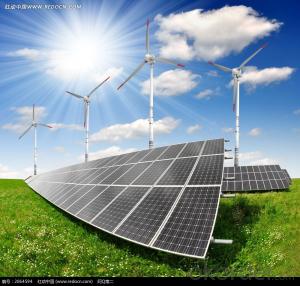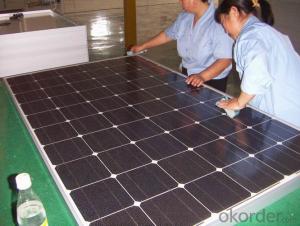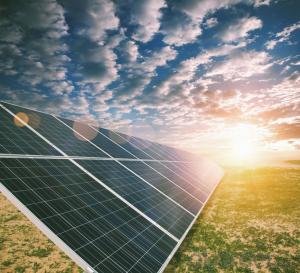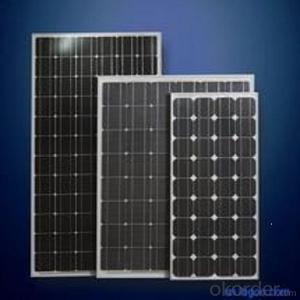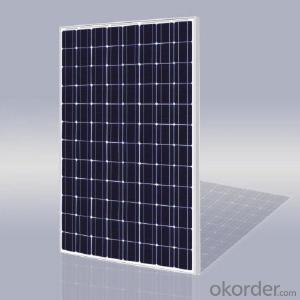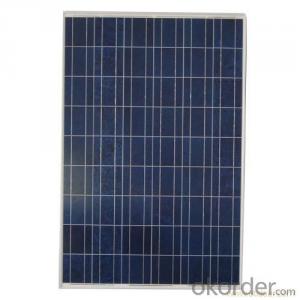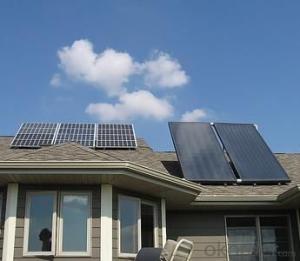Solar Panels Maine - High Efficiency Solar Panel Poly In Stock, Solar Module Panel
- Loading Port:
- Shanghai
- Payment Terms:
- TT OR LC
- Min Order Qty:
- 2500 watt
- Supply Capability:
- 26000 watt/month
OKorder Service Pledge
OKorder Financial Service
You Might Also Like
Specification
We now provide
• Monocrystalline Solar Panel
• Polycrystalline Solar Panel( multicrystalline silicon Solar Panel)
Features of our products:
• High conversion efficiency mono/poly-crystalline amorphous silicon solar cells
• Modules incorporate high performance bypass diodes to minimize the power drop caused by shading
• High transmittance, low-iron tempered glass
• High performance EVA encapsulant to prevent destroying and water.
• AI frame: without screw, corner connection. 8 holes on the frame can be installed easily
• Good performance of preventing from atrocious weather such as wind and hails
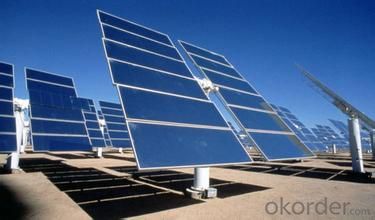
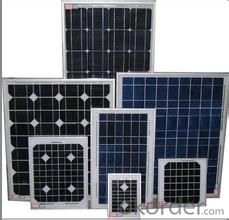
Polycrystalline Silicon Solar Modules 48Cell-195W Specification
ELECTRICAL PERFORMANCE | |||
Power output | P max | W | 195 |
Power output tolerances | ΔP max | W | 0/+5 |
Module effi ciency | η m | % | 14.7 |
Voltage at Pmax | V mpp | V | 23.7 |
Current at Pmax | I mpp | A | 8.03 |
Open-circuit voltage | V oc | V | 30.1 |
Short-circuit current | I sc | A | 8.65 |
Product Description:
This installation Manual contains essential information for the electrical and mechanical installation that your must know before installing CUSTOMER PV modules. This also contains safety information you need to be familiar with .All the information described in this manual are the intellectual property of CNBM and based on the technologies and experiences that have been acquired and accumulated in the long history of CUSTOMER. This document does not constitute a warranty, expressed or implied.
CUSTOMER does not assume responsibility and expressly disclaims liability for loss, damage, or expense arising out of in anyway connected with installation, operation, use or maintenance of the PV modules. No responsibility is assumed by CUSTOMER for any infringement of patents or other rights of third parties that may result from use of PV module.
CUSTOMER reserves the right to make changes to the product, specifications or installation manual without prior notice.
Solar panel working process
In addition to being the ultimate source of all life on earth, the sun is an infinitely renewable, completely pollution-free source of electricity. Instead of burning fossil fuels dug up from the ground in a big power plant – a very 19th century, industrial age approach, when you think about it – solar panels convert sunlight directly into electricity, with no harmful emissions.
The basic unit of a solar panel is a solar cell, which usually consists of one or two layers of silicon-based semiconductor wafers. When struck by the photons in sunlight, the solar cell generates an electrical charge due to the "photovoltaic effect" – which is a pretty good name, since it produces voltage from photons. The flow of these electrons moves in a steady electrical current from one side of the cell to the other.
Dozens of these PV cells are packaged together into solar modules, which in turn are packaged into solar panels that are mounted on a rooftop and arranged to maximize their hours of exposure to direct sunlight. Because the electricity generated by all those solar cells is direct current (DC), it is then sent to an inverter that transforms the power into the same alternating current (AC) used by the appliances in your home and the local utility electricity distribution grid. Increasingly, these inverters are getting "smart," providing data monitoring for solar installation performance and other grid integration services.
Solar Module Specification
Quality and Safety
1.Rigorous quality control meeting the highest international standards
2.High-transmissivity low-iron tempered glass, strong aluminium frame
3.Using UV-resistant silicon
4.ISO 9001:2008 and ISO 14001:2004
5.IEC61215, IEC61730, Safety Class in conformity to CE
- Q: Are there any restrictions or regulations regarding solar panel installations?
- Yes, there are restrictions and regulations regarding solar panel installations. These can vary depending on the country, state, or local municipality. Some common restrictions include zoning laws, building codes, and utility regulations. These regulations may dictate the size, placement, and connections of solar panels, as well as any necessary permits or approvals required for installation. It is important to consult with local authorities or a professional installer to ensure compliance with all applicable restrictions and regulations.
- Q: How do solar panels affect the local job market?
- Solar panels can have a positive impact on the local job market. Their installation and maintenance can create new employment opportunities in the renewable energy sector, leading to job growth. Additionally, the development of solar farms and manufacturing facilities can attract investments and create more jobs in the local economy.
- Q: How do solar panels affect the homeowner's insurance policy?
- Solar panels can affect a homeowner's insurance policy by potentially increasing the coverage limits and premiums. Since solar panels are considered an additional asset and may increase the replacement cost of the home, insurance companies may require homeowners to adjust their coverage accordingly. Additionally, the liability coverage may need to be increased to protect against any potential damages or injuries related to the solar panel system. It's advisable for homeowners to contact their insurance provider to discuss the specific impact on their policy.
- Q: This is for my science project and i cannot figure it outWe assumed that blue light shining on a solar panel would give off the higher volt reading because it has the shortest wavelength and the highest energy, but it was actually the lowest. Why does this happen? Im very confused And cant find the answer anywhere.... ,thank you!!
- Surely the highest volt reading will result from the wave with the largest amplitude, wavelength irrespective? You'd need to know the amplitude of the wave AFTER leaving the colour filter, since different chemicals and pigments in the filter would naturally affect the resulting wave in different ways.
- Q: How are solar panels installed?
- Solar panels are typically installed on rooftops or open ground areas. First, the area is assessed for its solar potential. Then, mounting structures are installed securely on the roof or ground. Next, solar panels are attached to these structures and wired together in a series or parallel configuration. Finally, the panels are connected to an inverter that converts the DC electricity generated by the panels into AC electricity for use in homes or businesses.
- Q: where can i get some solar panels for a camper trailer
- There are many suppliers for solar panels. Try camping shops, BQ or other leisure shops. Alternatively try one of the companies listed here:
- Q: I am starting to think about solar panels as an option for my home. I have done some research on panels, to be honest its all very confusing. There are many different panels some with 60 watts some all the way up to 20 watts. My household currently uses about 2700 to 3400 kWh every two months. So based off of my power usage maybe you can answer some of the following questions:What kind of panels should I be looking at?Which panel manufacturers give the best bang for the buck (reliable/affordable)?Anything else I should be concerned about?I am just starting out in educating myself on solar power so please excuse me if I sound very naive. Any information that you may have will be helpful. Thanks in advance.
- I'm not an expert, but I recently went through the process and now have a system on my home. I got 3 quotes from 3 licensed contractors and they all seemed to be about the same, the prices seemed to be based on the amount of energy they produced. In CA and I'm sure everywhere else they are tested by an independent agency which rates the output of the panels. You seem to have similar usage as my house, I got a 3.75kwhdc unit, it isn't expected to eliminate my bill, but it should reduce it by quite a bit. I've only had it for a few months and it took me from about 45 kwh per day to around 0. I know I'll have lower output in the winter, but my usage is lower in the winter as well. I decided on this size unit to maximize my rebates and I can take advantage of my utilities rebates when I add to the system in a few years. The difference between panels seemed to be how big they were. Some systems can be twice the size and produce the same amount of energy. I put a couple links below that I found helpful. The roseville pv buy down program has some great links that give information about specific systems.
- Q: How much energy can a solar panel generate?
- The amount of energy a solar panel can generate depends on various factors such as its size, efficiency, location, and weather conditions. On average, a standard solar panel can generate between 250 to 400 watts of electricity per hour under ideal conditions. However, it's important to note that energy production may vary throughout the day and across different seasons.
- Q: Simplfy it so i can understand pls and put it in stages such as . sun hits solar panel plsHow many different types of solar panels are there?
- Solar panels are made of a series of solar cells.solar cells are an electical device that convert sun energy directly into electicity by the photovoltaic effect,which is an physic and chemical phenomenon.solar cells are made of special materials called semiconductors such as silicon,which is currently used most commonly.Basically, when light strikes the cell, a certain portion of it is absorbed within the semiconductor material.This means that the energy of the absorbed light is transferred to the semiconductor. The energy knocks electrons loose, allowing them to flow freely.This flow of electrons is a current, this current, together with the cell's voltage (which is a result of its built-in electric field or fields), defines the power (or wattage) that the solar cell can produce.
- Q: Can solar panels be installed on a shaded roof?
- Solar panels can still be installed on a shaded roof, but their energy production may be significantly reduced. Shading from nearby trees, buildings, or other obstructions can block sunlight, impacting the panel's efficiency and overall output. It's important to assess the level and duration of shading to determine if solar panels on a shaded roof are a viable option.
Send your message to us
Solar Panels Maine - High Efficiency Solar Panel Poly In Stock, Solar Module Panel
- Loading Port:
- Shanghai
- Payment Terms:
- TT OR LC
- Min Order Qty:
- 2500 watt
- Supply Capability:
- 26000 watt/month
OKorder Service Pledge
OKorder Financial Service
Similar products
Hot products
Hot Searches
Related keywords










